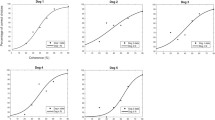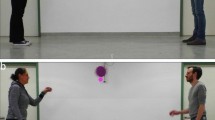Abstract
Knowledge about the mechanisms underlying canine vision is far from being exhaustive, especially that concerning post-retinal elaboration. One aspect that has received little attention is motion perception, and in spite of the common belief that dogs are extremely apt at detecting moving stimuli, there is no scientific support for such an assumption. In fact, we recently showed that dogs have higher thresholds than humans for coherent motion detection (Kanizsar et al. in Sci Rep UK 7:11259, 2017). This term refers to the ability of the visual system to perceive several units moving in the same direction, as one coherently moving global unit. Coherent motion perception is commonly investigated using random dot displays, containing variable proportions of coherently moving dots. Here, we investigated the relative contribution of local and global integration mechanisms for coherent motion perception, and changes in detection thresholds as a result of repeated exposure to the experimental stimuli. Dogs who had been involved in the previous study were given a conditioned discrimination task, in which we systematically manipulated dot density and duration and, eventually, re-assessed our subjects’ threshold after extensive exposure to the stimuli. Decreasing dot duration impacted on dogs’ accuracy in detecting coherent motion only at very low duration values, revealing the efficacy of local integration mechanisms. Density impacted on dogs’ accuracy in a linear fashion, indicating less efficient global integration. There was limited evidence of improvement in the re-assessment but, with an average threshold at re-assessment of 29%, dogs’ ability to detect coherent motion remains much poorer than that of humans.



Similar content being viewed by others
Notes
In the vision literature this parameter is also called lifetime.
References
Aguirre GK, Komáromy AM, Cideciyan AV, Brainard DH, Aleman TS, Roman AJ, Avants BB, Gee JC, Korczykowski M, Hauswirth WW, Acland GM (2007) Canine and human visual cortex intact and responsive despite early retinal blindness from RPE65 mutation. PLoS Med 4:e230. https://doi.org/10.1371/journal.pmed.0040230
Albuquerque N, Guo K, Wilkinson A, Savalli C, Otta E, Mills D (2016) Dogs recognize dog and human emotions. Biol Lett 12: 20150883. https://doi.org/10.1098/rsbl.2015.0883
Bertenthal BI, Pinto J (1994) Global processing of biological motions. Psychol Sci 5:221–225. https://doi.org/10.1111/j.1467-9280.1994.tb00504.x
Bischof WF, Reid SL, Wylie DR, Spetch ML (1999) Perception of coherent motion in random dot displays by pigeons and humans. Percept Psychophys 61:1089–1101. https://doi.org/10.3758/BF03207616
Blanke O, Brooks A, Mercier M, Spinelli L, Adriani M, Lavanchy L, Safran AB, Landis T (2007) Distinct mechanisms of form-from-motion perception in human extrastriate cortex. Neuropsychol 45:644–653. https://doi.org/10.1016/j.neuropsychologia.2006.07.019
Braddick O (1993) Segmentation vs integration in visual motion processing. Trends Neorosci 16:263–268. https://doi.org/10.1016/0166-2236(93)90179-P
Brainard DH (1997) The psychophysics toolbox. Spat Vis 10:433–436
Britten KH, Shadlen MN, Newsome WT, Movshon J (1992) The analysis of visual motion: a comparison of neuronal and psychophysical performance. J Neurosci 12:4745–4765
Byosiere SE, Chouinard PA, Howell TJ, Bennett PC (2017a) What do dogs (Canis familiaris) see? A review of vision in dogs and implications for cognition research. Psychon Bull Rev. https://doi.org/10.3758/s13423-017-1404-7
Byosiere SE, Feng LC, Chouinard PA, Howell TJ, Bennett PC (2017b) Relational concept learning in domestic dogs: Performance on a two-choice size discrimination task generalises to novel stimuli. Behav Process 145:93–101. https://doi.org/10.1016/j.beproc.2017.10.009
Djavadian RL, Harutiunian-Kozak BA (1987) Retinotopic organization of the lateral suprasylvian area of the cat. Acta Neurobiol Exp 43:251–262
Dosher BA, Lu ZL (2005) Perceptual learning in clear displays optimizes perceptual expertise: Learning the limiting process. Proc Natl Acad Sci USA 102:5286–5290. https://doi.org/10.1073/pnas.0500492102
Douglas RM, Neve A, Quittenbaum JP, Alam NM, Prusky GT (2006) Perception of visual motion coherence by rats and mice. Vis Res 46:2842–2847. https://doi.org/10.1016/j.visres.2006.02.025
Fahle M, Henkle-Fahle S (1996) Interobserver variance in perceptual performance and learning. Invest Ophth Vis Sci 37:869–877
Gácsi M, Miklósi Á, Varga O, Topál J, Csányi V (2004) Are readers of our face readers of our minds? Dogs (Canis familiaris) show situation-dependent recognition of human’s attention. Anim Cogn 7:144–153. https://doi.org/10.1007/s10071-003-0205-8
Gizzi MS, Katz E, Movshon JA (1990) Spatial and temporal analysis by neurons in the representation of the central visual field in the cat’s lateral suprasylvian visual cortex. Vis Neurosci 5:463–468. https://doi.org/10.1017/S0952523800000584
Humphrey AL, Saul AB (2002) The emergence of direction selectivity in cat primary visual cortex. In: Payne B, Peters A (eds) The cat primary visual cortex. Academic Press, London, pp 343–386
Huxlin KR, Pasternak T (2004) Training-induced recovery of visual motion perception after extrastriate cortical damage in the adult cat. Cereb Cortex 14:81–90. https://doi.org/10.1093/cercor/bhg106
Kaminski J, Nitzschner M (2013) Do dogs get the point? A review of dog–human communication ability. Learn Motiv 44:294–302. https://doi.org/10.1016/j.lmot.2013.05.001
Kanizsar O, Mongillo P, Battaglini L, Campagna G, Marinelli L (2017) Dogs are not better than humans at detecting coherent motion. Sci Rep UK 7:11259. https://doi.org/10.1038/s41598-017-11864-z
Milgram NW, Head E, Weiner E, Thomas E (1994) Cognitive functions and aging in the dog: acquisition of nonspatial visual tasks. Behav Neorosci 108:57. https://doi.org/10.1037/0735-7044.108.1.57
Miller PE, Murphy CJ (1995) Vision in dogs. J Am Vet Med Assoc 15:1623–1634
Mongillo P, Pitteri E, Sambugaro P, Carnier P, Marinelli L (2017a) Global bias reliability in dogs (Canis familiaris). Anim Cogn 20:257–265. https://doi.org/10.1007/s10071-016-1044-8
Mongillo P, Scandurra A, Kramer RSS, Marinelli L (2017b) Recognition of human faces by dogs (Canis familiaris) requires visibility of head contour. Anim Cogn 20:881–890. https://doi.org/10.1007/s10071-017-1108-4
Nagasawa M, Murai K, Mogi K, Kikusui T (2011) Dogs can discriminate human smiling faces from blank expressions. Anim Cogn 14:525–533. https://doi.org/10.1007/s10071-011-0386-5
Newsome WT, Pare BT (1988) A selective impairment of motion perception following lesions of the middle temporal visual area (MT). J Neurosci 8:2201–2211
Pelli DG (1997) The VideoToolbox software for visual psychophysics: transforming numbers into movies. Spat Vis 10:437–442. https://doi.org/10.1163/156856897X00366
Pitteri E, Mongillo P, Carnier P, Marinelli L (2014a) Hierarchical stimulus processing by dogs (Canis familiaris). Anim Cogn 17:869–877. https://doi.org/10.1007/s10071-013-0720-1
Pitteri E, Mongillo P, Carnier P, Marinelli L, Huber L (2014b) Part-based and configural processing of owner’s face in dogs. PLoS One 9:e108176. https://doi.org/10.1371/journal.pone.0108176
Prins N, Kingdom FAA (2009) Palamedes: matlab routines for analyzing psychophysical data. http://www.palamedestoolbox.org. Accessed 12 Sept 2017
Rudolph KK, Pasternak T (1996) Lesions in cat lateral suprasylvian cortex affect the perception of complex motion. Cereb Cortex 6:814–822. https://doi.org/10.1093/cercor/6.6.814
Rust NC, Mante V, Simoncelli EP, Movshon JA (2006) How MT cells analyze the motion of visual patterns. Nat Neurosci 9:1421
Sagi D (2011) Perceptual learning in vision research. Vis Res 51:1552–1566. https://doi.org/10.1016/j.visres.2010.10.019
Snowden RJ, Kavanagh E (2006) Motion perception in the ageing visual system: minimum motion, motion coherence, and speed discrimination thresholds. Perception 35:9–24. https://doi.org/10.1068/p5399
Talcott JB, Hansen PC, Assoku EL, Stein JF (2000) Visual motion sensitivity in dyslexia: evidence for temporal and energy integration deficits. Neuropsychologia 38:935–943. https://doi.org/10.1016/S0028-3932(00)00020-8
Thompson B, Liu Z (2006) Learning motion discrimination with suppressed and un-suppressed MT. Vis Res 46:2110–2121. https://doi.org/10.1016/j.visres.2006.01.005
Virányi Z, Topál J, Gácsi M, Miklósi Á, Csányi V (2004) Dogs respond appropriately to cues of humans’ attentional focus. Behav Process 66:161–172. https://doi.org/10.1016/j.beproc.2004.01.012
Watanabe T, Nanez JE, Sasaki Y (2001) Perceptual learning without perception. Nature 413:844–847. https://doi.org/10.1038/35101601
Weiffen M, Mauck B, Dehnhardt G, Hanke FD (2014) Sensitivity of a harbor seal (Phoca vitulina) to coherent visual motion in random dot displays. Springerplus 3:688. https://doi.org/10.1186/2193-1801-3-688
Williams D, Brannan J (1994) Spatial integration of local motion signals. In: Smith A, Snowden R (eds) Visual detection of motion. Academic Press, London, pp 291–303
Wurtz RH, Kandel ER (2000) Perception of motion, depth and form. In: Kandel ER, Schwarts JH, Jessel TM (eds) Principles of neural science, 4th edn. McGraw-Hill, New York, pp 548–571
Acknowledgements
We are very grateful to the student Giulia Madumali Zotti for helping with the experiments and to Dr. Carlo Poltronieri for his technical assistance. The study was funded by the University of Padova (to LM, 2016 - prot. DOR1673431). Dr. Orsolya Kanizár was supported by a PhD grant funded by the University of Padova.
Author information
Authors and Affiliations
Corresponding author
Ethics declarations
Ethical approval
None of the authors of this paper has any financial or personal relationship with other people or organizations which might inappropriately influence or bias its content.
Human and animal rights
All applicable international, national, and/or institutional guidelines for the care and use of animals were followed.
Electronic supplementary material
Below is the link to the electronic supplementary material.
Rights and permissions
About this article
Cite this article
Kanizsár, O., Mongillo, P., Battaglini, L. et al. The effect of experience and of dots’ density and duration on the detection of coherent motion in dogs. Anim Cogn 21, 651–660 (2018). https://doi.org/10.1007/s10071-018-1200-4
Received:
Revised:
Accepted:
Published:
Issue Date:
DOI: https://doi.org/10.1007/s10071-018-1200-4




